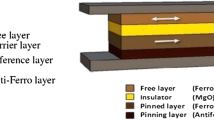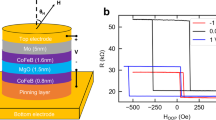Abstract
As the conventional von Neumann architecture meets critical limitations of data transfer bandwidth and energy consumption, perpendicular magnetic anisotropy magnetic tunnel junction based processing-in-memory paradigm attracts extensive attention as a promising substitute thanks to its non-volatility, low-power switching, fast access and infinite endurance. In this work, we propose and experimentally demonstrate a new spintronic implication logic gate that consists of two parallel perpendicular magnetic anisotropy magnetic tunnel junctions with different diameters. Material implication and furthermore NAND logic functions are implemented by all electrically-controlled operations. The reliability of this structure is verified, especially in sub-20 nm node, which shows great potential for large-density processing-in-memory applications.
Similar content being viewed by others
References
Shannon C E. A symbolic analysis of relay and switching circuits. Electr Eng, 1938, 57: 713–723
Borghetti J, Snider G S, Kuekes P J, et al. ‘Memristive’ switches enable ‘stateful’ logic operations via material implication. Nature, 2010, 464: 873–876
Kim N S, Austin T, Blaauw D, et al. Leakage current: Moore’s law meets static power. Computer, 2003, 36: 68–75
Shulaker M M, Hills G, Park R S, et al. Three-dimensional integration of nanotechnologies for computing and data storage on a single chip. Nature, 2017, 547: 74–78
Li Y, Zhou Y X, Wang Z R, et al. Memcomputing: fusion of memory and computing. Sci China Inf Sci, 2018, 61: 060424
Gao M, Ayers G, Kozyrakis C. Practical near-data processing for in-memory analytics frameworks. In: Proceedings of International Conference on Parallel Architecture and Compilation (PACT), San Francisco, 2015. 123–124
Chen B, Cai F X, Zhou J T, et al. Efficient in-memory computing architecture based on crossbar arrays. In: Proceedings of IEEE International Electron Devices Meeting (IEDM), Washington, 2015
Ahn J, Hong S, Yoo S, et al. A scalable processing-in-memory accelerator for parallel graph processing. In: Proceedings of the 42nd Annual International Symposium on Computer Architecture, New York, 2015. 105–117
Li S C, Xu C, Zou Q S, et al. Pinatubo: a processing-in-memory architecture for bulk bitwise operations in emerging non-volatile memories. In: Proceedings of the 53rd Annual Design Automation Conference, New York, 2016
Cao K H, Cai W L, Liu Y Z, et al. In-memory direct processing based on nanoscale perpendicular magnetic tunnel junctions. Nanoscale, 2018, 10: 21225–21230
Yang Y C, Chen B, Lu W D. Memristive physically evolving networks enabling the emulation of heterosynaptic plasticity. Adv Mater, 2015, 27: 7720–7727
Kent A D, Worledge D C. A new spin on magnetic memories. Nat Nanotech, 2015, 10: 187–191
Wang L Z, Kang W, Ebrahimi F, et al. Voltage-controlled magnetic tunnel junctions for processing-in-memory implementation. IEEE Electron Device Lett, 2018, 39: 440–443
Suh D I, Kil J P, Kim K W, et al. A single magnetic tunnel junction representing the basic logic functions — NAND, NOR, and IMP. IEEE Electron Device Lett, 2015, 36: 402–404
Slesazeck S, Mikolajick T. Nanoscale resistive switching memory devices: a review. Nanotechnology, 2019, 30: 352003
Peng S Z, Zhao W S, Qiao J F, et al. Giant interfacial perpendicular magnetic anisotropy in MgO/CoFe/capping layer structures. Appl Phys Lett, 2017, 110: 072403
Kent A D. Spintronics: perpendicular all the way. Nat Mater, 2010, 9: 699–700
Wang M X, Cai W L, Cao K H, et al. Current-induced magnetization switching in atom-thick tungsten engineered perpendicular magnetic tunnel junctions with large tunnel magnetoresistance. Nat Commun, 2018, 9: 671
Slonczewski J C. Current-driven excitation of magnetic multilayers. J Magn Magn Mater, 1996, 159: 1–7
Berger L. Emission of spin waves by a magnetic multilayer traversed by a current. Phys Rev B, 1996, 54: 9353–9358
Ikeda S, Miura K, Yamamoto H, et al. A perpendicular-anisotropy CoFeB-MgO magnetic tunnel junction. Nat Mater, 2010, 9: 721–724
D’Souza N, Biswas A, Ahmad H, et al. Energy-efficient switching of nanomagnets for computing: straintronics and other methodologies. Nanotechnology, 2018, 29: 442001
Lee J, Suh D I, Park W. The universal magnetic tunnel junction logic gates representing 16 binary Boolean logic operations. J Appl Phys, 2015, 117: 17D717
Mahmoudi H, Windbacher T, Sverdlov V, et al. Reliability analysis and comparison of implication and reprogrammable logic gates in magnetic tunnel junction logic circuits. IEEE Trans Magn, 2013, 49: 5620–5628
Sato H, Enobio E C I, Yamanouchi M, et al. Properties of magnetic tunnel junctions with a MgO/CoFeB/Ta/CoFeB/MgO recording structure down to junction diameter of 11 nm. Appl Phys Lett, 2014, 105: 062403
Sun J Z, Brown S L, Chen W, et al. Spin-torque switching efficiency in CoFeB-MgO based tunnel junctions. Phys Rev B, 2013, 88: 104426
Zhao W, Moreau M, Deng E, et al. Synchronous non-volatile logic gate design based on resistive switching memories. IEEE Trans Circ Syst I, 2014, 61: 443–454
Sato H, Yamanouchi M, Ikeda S, et al. Perpendicular-anisotropy CoFeB-MgO magnetic tunnel junctions with a MgO/CoFeB/Ta/CoFeB/MgO recording structure. Appl Phys Lett, 2012, 101: 022414
Watanabe K, Jinnai B, Fukami S, et al. Shape anisotropy revisited in single-digit nanometer magnetic tunnel junctions. Nat Commun, 2018, 9: 663
Acknowledgements
This work was supported by National Natural Science Foundation of China (Grant Nos. 61571023, 61627813), International Collaboration Project (Grant No. B16001), National Key Technology Program of China (Grant No. 2017ZX01032101), and Academic Excellence Foundation of BUAA for Ph.D. Students.
Author information
Authors and Affiliations
Corresponding authors
Additional information
Supporting information
Appendixes A and B. The supporting information is available online at info.scichina.com and link.springer.com. The supporting materials are published as submitted, without typesetting or editing. The responsibility for scientific accuracy and content remains entirely with the authors.
Supplementary File
Rights and permissions
About this article
Cite this article
Cai, W., Wang, M., Cao, K. et al. Stateful implication logic based on perpendicular magnetic tunnel junctions. Sci. China Inf. Sci. 65, 122406 (2022). https://doi.org/10.1007/s11432-020-3189-x
Received:
Revised:
Accepted:
Published:
DOI: https://doi.org/10.1007/s11432-020-3189-x




